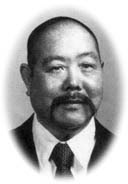[Master Wang from “Bagua Zhang and the I Ching” chapter]
 Zhen: The trigram shape is symbolized by a basin standing upright. The principle is one of vibrating or quaking. Powerful actions bring fearful reactions that will lead to order and control. The awe of power opens the way. The palm form is ling, to lead. In practice ling emulates the form of Zhen—yielding above but firm below, seeking movement within stillness. This is the birth of yang. The intention is one of searching deeply and unpredictable change. The third form, The Hawk Swoops Upward, utilizes the technique of ling as its theme. If practiced correctly the liver's chi will be harmonized; if not you will become easily angered.
Zhen: The trigram shape is symbolized by a basin standing upright. The principle is one of vibrating or quaking. Powerful actions bring fearful reactions that will lead to order and control. The awe of power opens the way. The palm form is ling, to lead. In practice ling emulates the form of Zhen—yielding above but firm below, seeking movement within stillness. This is the birth of yang. The intention is one of searching deeply and unpredictable change. The third form, The Hawk Swoops Upward, utilizes the technique of ling as its theme. If practiced correctly the liver's chi will be harmonized; if not you will become easily angered.[Master Wang from "The Hawk Swoops Upward" chapter]
As you walk the circle in a left guard posture, toe-in with the right foot turning to the left and facing the center of the circle. Spin on the ball of the left foot so you perform a 180° left turn and step to the left. The right foot steps forward beside the left with feet parallel (the back faces the center of the circle). At the same time turn the right palm toward the chest in an upward motion. The movement contains the idea of drilling and the arm forms a half-moon shape. The left hand holds its original shape with the palm turned outward and pressing down. Keep the arm bent and held in front of the stomach. The body posture is upright and natural.
Continuing on from above, turn the toes of both feet inward as you twist your upper body to the left using the power of the waist. Shift the weight to your right foot and turn your head to look left. Take a long step to the rear with your left foot, in the manner of "Snake Creeps Down" (a movement from Taiji Quan). Both palms turn downward and spread in opposite directions with a feeling of being "outwardly stretched and internally bound." The left palm reaches toward the left foot—the lower the better. (Of course, how low you go will depend upon your strength and balance.) The right palm pushes off to the upper right. Both elbows are bent giving the arms the shape of a half moon.
To complete the form, turn your left toes outward and shift your weight onto the left foot. At the same time, twist your left palm outward and push frontward into a left forward stance. Next place your right foot even with the left without adding weight. At the same time, the right hand turns palm upward and drills under the left elbow. Finish as you did the Single Palm Change by sweeping the right palm under the left, stepping the right foot forward, and twisting the waist to the right with the arms forming a right guard stance.
[Translator's Commentary, by Kent Howard]
The third form, or gua, in Wang Shujin's 'Bagua Zhang Connected Palms' is called, The Hawk Swoops Upward. A more precise English translation could be, The Hawk Flies in the Sky. But this would be missing the mark. The main action of the form is a downward movement that arcs the forward hand near the ground before sweeping upward again. The motion is much like a raptor diving on its prey and carrying it off into the sky. In other Bagua Zhang styles this move is called Swallow Skims Water, because it mimics the actions of a Barn Swallow drinking water from a pond while on the fly.
The hand method used in this form is one of grasping; while the action is that of leading. In application, you intercept the opponent's attack only to redirect him into a spiraling movement that ends with him being thrown to the ground. The Hawk Swoops Upward is one of the most beautiful of the eight forms, and, yet, it is also one of the most difficult to execute properly. You need steady balance to perform the downward spiraling 360° turn and strong legs to execute the low, sweeping attack.
Zhen is the trigram traditionally associated with The Hawk Swoops Upward. The soft, fluid movements of the upper body are supported by the steady platform of the legs below. You can see this in the structure of the trigram, yin on top is supported by yang below. The two yin lines above represent the more pliant axial-skeleton (i.e. shoulders through hips), and the solid yang line below symbolizes the sturdier legs. The secret to the Hawk's martial power is being externally firm while remaining internally active. The masters have said that if the form is executed correctly, the liver's qi will be in harmony.
The commentary on Zhen found in the Yi Jing seems to illuminate and validate the qualities of the martial form: "Zhen the Arousing incites movement. A yang line develops below two yin and presses up forcibly....the movement is within the mind. You should not resist or yield, but stay in the center of motion." This appears to echo Master Wang's dictum of keeping to “stillness within movement.”





























